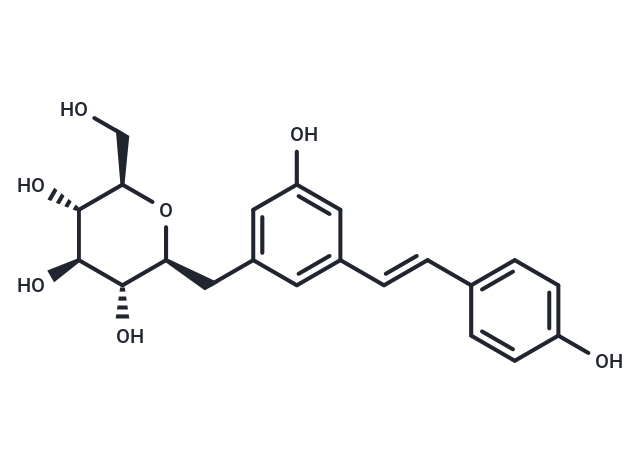Shopping Cart
- Remove All
 Your shopping cart is currently empty
Your shopping cart is currently empty

Polydatin (Piceid), the glycoside of Resveratrol, is originally isolated from the Chinese herb Polygonum cuspidatum. The compound can inhibit platelet aggregation and elevate the ratios of LDL-C/HDL-C and TC/HDL-C. In the myocardial cell, white blood cell, vascular smooth muscle cell, and endothelial cell, Polydatin can inhibit ICAM-1 expression, elevate Ca2+, weaken white blood cell-endothelial cell adhesion, and activate KATP channels.

| Pack Size | Price | Availability | Quantity |
|---|---|---|---|
| 50 mg | $41 | In Stock | |
| 100 mg | $66 | In Stock | |
| 500 mg | $148 | In Stock | |
| 1 mL x 10 mM (in DMSO) | $45 | In Stock |
| Description | Polydatin (Piceid), the glycoside of Resveratrol, is originally isolated from the Chinese herb Polygonum cuspidatum. The compound can inhibit platelet aggregation and elevate the ratios of LDL-C/HDL-C and TC/HDL-C. In the myocardial cell, white blood cell, vascular smooth muscle cell, and endothelial cell, Polydatin can inhibit ICAM-1 expression, elevate Ca2+, weaken white blood cell-endothelial cell adhesion, and activate KATP channels. |
| In vitro | Polydatin protects cerebral cells from ischemic damages via improvement of microcirculation and inhibition of platelet aggregation. In addition, polydatin inhibits ICAM-1 expression in endothelial cells stimulated by lipopolysaccharide; it also attenuates adhesion between white blood cells and endothelial cells[1]. |
| In vivo | Polydatin could significantly increase the activity of SOD and the heart rate, attenuate myocardial pathological damage, decrease MDA content, slightly increase arterial pressure and GSH-Px activity, reduce intervals of QRS, QT and ST, and lower FFA content[2]. The combination of polydatin and vitamin C could significantly increase arterial pressure and heart rate, decrease QRS interval and slightly reduce ST and QT intervals, significantly attenuate myocardial pathological damage, increase the activities of GSH-Px,T-SOD, Na+ K+ -ATPase, and Ca2+ Mg2+ -ATPase, elevate phosphocreatine (PCr) and adenosine triphosphate (ATP) contents, slightly increase adenosine diphosphate (ADP) and total adenine nucleotide (TAN) contents and PCr/ATP, and significantly decrease the contents of MDA and FFA, when compared with those in the DOX group. |
| Cell Research | The effect of polydatin on mMEC viability is evaluated with an MTT assay. mMECs are incubated in the presence or absence of various concentrations of polydatin (25, 50 and 100 μg/mL) and DEX (100 μg/mL) for 24 h. Next, 20 μL of MTT (5 mg/mL) is added to each well and incubated for 4 h. After the supernatants are removed and the formazan is dis?solved with 150 μL of DMSO in each well, the optical density (OD) value is measured at 570 nm on a microplate reader[3]. |
| Alias | Polydotin Peceid, Piceid |
| Molecular Weight | 390.38 |
| Formula | C20H22O8 |
| Cas No. | 27208-80-6 |
| Smiles | OC[C@H]1O[C@@H](Cc2cc(O)cc(\C=C\c3ccc(O)cc3)c2)[C@H](O)[C@@H](O)[C@@H]1O |
| Relative Density. | 1.433g/cm3 |
| Storage | keep away from moisture | Powder: -20°C for 3 years | In solvent: -80°C for 1 year | Shipping with blue ice. | |||||||||||||||||||||||||||||||||||
| Solubility Information | DMSO: 60 mg/mL (153.7 mM), Sonication is recommended. | |||||||||||||||||||||||||||||||||||
Solution Preparation Table | ||||||||||||||||||||||||||||||||||||
DMSO
| ||||||||||||||||||||||||||||||||||||

Copyright © 2015-2025 TargetMol Chemicals Inc. All Rights Reserved.